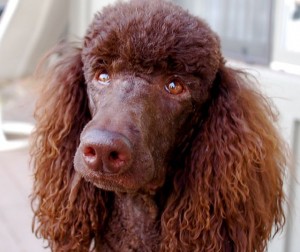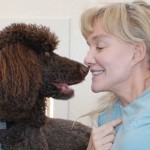Let’s begin with two little exercises.
1. Copy and paste the following sentence into your word processor, then run your “grammar checker”:
“The dog who ran outside to play in the snow yelped with delight.”
I’m running Microsoft Word 11.3.5 and here’s what the grammar checker told me to do: Change “who” to “that.”
I’ll come back to that that later on. Let’s move on to our next exercise.
2. Following are two sentences. Rewrite the second sentence replacing the words in bold type with other words, not proper names, without changing the meaning of the sentence:
“Tom has a new dog. Tom has named the dog Max and Tom lets the dog sleep by Tom’s bed.”
Did you rewrite it the ‘proper’ way? This way?: “Tom has a new dog. He has named it Max and he lets it sleep by his bed.” (Reference Wikipedia.)
Or, did you rewrite it like I did, and, as I believe Jane Goodall would have. (You’ll see why in a moment.): “Tom has a new dog. He named him Max and lets him sleep in his (Tom’s) bed.“
I don’t care what my grammar checker told me to do, I’m not switching “who” to “that.” And I don’t give a damn if “it” is the proper way to refer to a dog. I’m not going to do it.
Why not? Well, I was about to launch into what I’m sure would have been a way-too-lengthy discourse about how traditional English language use “thingifies” non-human animals, in particular dogs, when I stumbled upon this:
In her 1990 book Through a Window, Jane Goodall (www.janegoodall.org) writes that although scientists have long accepted that humans and other animals share physical characteristics, acceptance by scientists and the general public of nonhuman animals as individuals with feelings, as sentient beings, has been slow and grudging. In the early 1960s, when Goodall started her research with chimpanzees in Africa, scientists in her field gave numbers, not names to the chimpanzees they were studying. When Goodall submitted her first scientific paper for publication, it was returned to her by the editor to be amended. In every place where she had written he or she to refer to chimpanzees, the words had been replaced with it. Similarly, every who had been replaced with which. In an effort to rescue the chimpanzees from ‘thing-ness’ and restore them to ‘being-ness,’ Goodall stubbornly changed the words back and, in the end, won a small battle in what was to be an ongoing struggle to tear down, one by one, some of the bricks in the wall of superiority that humans had built to separate themselves from other animals. (Reference George Jacobs.)
Exactly. Language matters. A lot. And, it’s implications are legion.
Now I’m guessing that a few of you, maybe more, are catching a whiff of the dreaded “anthropomorphism,” you know, that totally “unscientific,” “non-objective,” creepy-to-some thing we do with non-human animals when we attribute assumed human qualities, motivations, and emotions to them.
Well, anthropomorphism has been on my mind. It’s a slippery and controversial concept without an agreed-upon definition. Think about it. How do you know anthropomorphism when you see it? One person’s anthropomorphism is another’s “is-ness.” It’s just what is. I love all the confusion and controversy. So, I’m planning a series of posts under the rubric: “Anthropomorphism: The good, the bad, and the ugly.”
This is my first salvo in the “good” category.











[…] This post was mentioned on Twitter by Rod Burkert, Kim Clune. Kim Clune said: Checking out: My Dog, Sadie, Is a “Who” http://bit.ly/aqsN7W (via @boulderdog1) […]
I had to do that for my grad thesis about dogs. Couldn’t even use Him or Her.
I’m so sorry!
Deborah,
Thank you for an excellent blog! Calling animals “it” is a pet peeve of mine, no pun intended! In my books I use the technically improper “who” rather than “it” or “that” when referring to dogs, because grammar be damned, dogs are not inanimate objects. I used to work for a veterinarian who used “it” to refer to the dogs. I hated it, and I’ll bet the clients did, too.
Nicole Wilde, author “Help for Your Fearful Dog,” “Don’t Leave Me!” and other books that give dogs the grammatical respect they deserve.
Awesome! Keep it up! 🙂
Science, which once kept us from acknowledging the emotional lives our dogs may redeem itself by proving how similar the workings of our brains actually are. Go team!
I hope so.
Yes, of course words are important. We use language to deal with things that make us uncomfortable. That’s why some people say “beef” and others say “cow.”
I believe the scientists (and others) who are most afraid of anthropomorphism are those who fear having their own defenses breached.
I think “uncomfortable” is correct. Often when we feel uncomfortable with or about something and we’re not sure why (and even if we are) that discomfort is revealed in the language we use and how we use it.
A total and utter pet peeve of mine, Deborah! For dogs and all other beings as well…. I’m constantly asking folks to think about re-phrasing “it” statements, for wild animals as well. Assign a gender even if the gender is not known. Calling a non human being “It” guarantees “separateness”, that other species are considered “objects” and not “subjects”. Sallie McFague, in “Body of God” speaks about this.
Thank you for your comment and for mentioning Body of God. It’s on my reading list now.
@Pamela, That’s an interesting theory, I think you nailed it there.
It always throws me off, actually, when people refer to an animal, even a fish, as an “it.” A fish, a dog, a snake, a tiger, they are all living beings with biological sexes. I don’t think it is anthropomorphizing to call a cat, “she”, after all, the cat is a she, not an it. That doesn’t mean you are calling the cat a human. I didn’t realise that using these pronouns was not technically proper grammar. Given that we know so much more about animals now than we did when these rules were put in place, I think it is time this changed.
I can’t recall when this sore subject hit me exactly, but it was the latter half of the 90s – I remember getting, yes, really uncomfortable with all the reference to dogs and cats as objects. It was not long after joining Lake Shore that I started correcting friends and colleagues and myself too when I slipped into old habits. Great project – I look forward to “it” getting the stuffing knocked out it;)
I see this a lot more on British websites and dog writing than among American dog writers. Even though I’m sure the Brits love their dogs, they always refer to them as “it” whereas Americans I know rarely do.
I guess we could start another discussion about Brits following rules vs Americans doing their own thing!
We can’t have this discussion in French language; we say “il” for a man or a male dog; we say “elle” for a woman or a female dog. And “who” and “that” are translated by a one word “qui”.
Thanks for this discussion! It’s so interesting
And thanks for your good blog!
Very interesting. Thank you for commenting.
In German we have all three “genders”, er (he), sie (she) and “es (it) but it is “der Hund” with the male article so people refer to “him” if they don’t know the gender of the dog. If they know it or refer to their own dog they use “er” (male) or “sie” (female) . People who don’t care about dogs use always “er”.